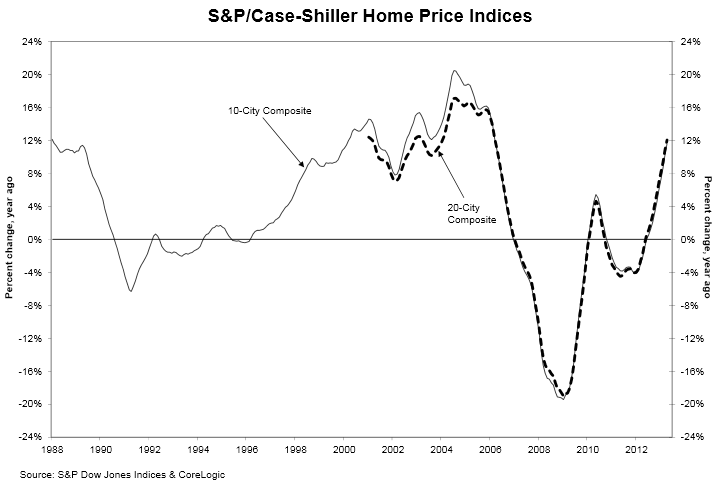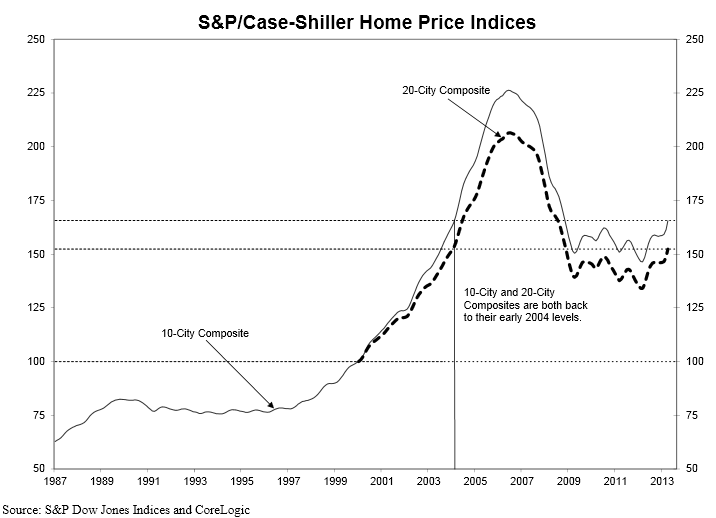Home prices rose faster from March to April than they ever have in the history of the Case Shiller Indices the S&P/Case-Shiller announced today. The 10-City and 20-City Composites posted monthly gains of 2.6 percent and 2.5 percent respectively. Nineteen of the 20 cities tracked by the composites were up for the month; Detroit was the sole exception.
The two indices and all twenty cities posted positive annual returns for at least the fourth straight month. The 10-City was 11.6 percent higher than in April 2012 and the 20-City Composite was up 12.1 percent. Among the cities, Atlanta, Dallas, Detroit, and Minneapolis posted the highest gains since each was added to their respective index.

David M. Blitzer, Chairman of the Index Committee at S&P Dow Jones Indices said that, in addition to the historically high monthly gain for the Composites, 13 cities posted monthly increases of more than two percentage points with San Francisco adding 4.9 percent to its number.
"The recovery is definitely broad-based," Blitzer said. "The two Composites showed the largest year-over-year gains in seven years. Atlanta, Las Vegas, Phoenix and San Francisco posted year-over-year gains of over 20 percent in April. San Francisco was the highest at 23.9 percent. Phoenix posted 12 consecutive months of double-digit growth. Recent economic data on home sales and inventories confirm the housing recovery's strength."
Blitzer noted that the sharp increases in Treasury yields and the Federal Reserve's comments about its future actions had sparked fears of rising interest rates and what they might do to housing's recovery. But he added, "Home buyers have survived rising mortgage rates in the past, often by shifting from fixed rate to adjustable rate loans. In the housing boom, bust and recovery, banks' credit quality standards were more important than the level of mortgage rates. The most recent Fed Senior Loan Officer Opinion Survey shows that some banks are easing credit restrictions. Given this, the recovery should continue."

As of April, average home prices in the U.S. Are back to early 2004 levels for both Composites. Measured from their June/July 2006 peaks, prices for the Composites are down about 26 percent and the 10 and 20-City indices are up off of their March 2012 lows by 13.1 percent and 13.6 percent respectively.
Annual gains among the 20 cities ranged from a low of 3.2 percent in New York to the 23.9 percent noted above for San Francisco. Other notable annual increases were 22.3 percent for Las Vegas, 21.5 percent in Phoenix, and 20.8 percent in Atlanta. California cities were seeing what the report called impressive returns all around, with gains ranging from 3.4 percent to 4.9 percent. Los Angeles, San Diego, and San Francisco posted their highest gains since 2004, 1988, and 1987 respectively. On the east coast, Miami showed its biggest increase in over seven years, 2.4 percent.
The S&P/Case-Shiller Home Price Indices track the price path of typical single-family homes located in each of the 20 cities in the two Composites. Each index combines matched price pairs for thousands of individual houses from the available universe of arms length sales data. The indices have a base value of 100 in January 2000, thus a current index value of 150 translates to a 50 percent appreciation rate since January 2000 for a typical home located within the subject market.







